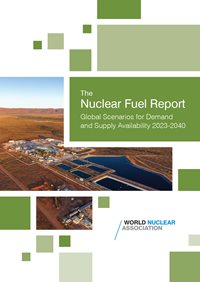The Nuclear Fuel Report
Global Scenarios for Demand and Supply Availability 2023-2040
The 21st edition of the World Nuclear Association's biennial report on the outlook for nuclear power and nuclear fuels. It is the definitive reference source of the world industry and is available at a price of £1200.
The report can be ordered from our website shop

The global effort to decarbonize energy supplies, heightened political commitment to ensuring energy security and sovereignty, and growing interest in deploying SMRs along with larger reactors has led to significant increases in projections for future nuclear capacity, and demand for nuclear fuel cycle services, in the latest edition of the Nuclear Fuel Report: Global Scenarios for Demand and Supply Availability 2023-2040.
The report considers three scenarios, the Reference Scenario, informed by government and utility targets and objectives, the Lower Scenario, which assumes delays in implementing these plans, and the Upper Scenario, which is underpinned by more favourable conditions, largely reflecting the targets announced in many countries to achieve net-zero carbon emissions, and the acceptance that nuclear power will play an indispensable role in reaching this goal.
From the current 391 GWe of operable nuclear capacity, the Reference Scenario projects that nuclear capacity will reach 686 GWe by 2040 (up 71 GWe from the 2021 edition), with capacity reaching 931 GWe in the Upper Scenario (up 92 GWe) and 486 GWe in the Lower Scenario (up 37 GWe).
World reactor requirements for uranium in 2023 are estimated at about 65,650 tU. In the Reference Scenario these are expected to rise to almost 130,000 tU in 2040, with requirements rising to 184,300 tU in the Upper Scenario and nearly 87,000 tU in the Lower Scenario by the same date.
Geopolitical instability, notably resulting from the Russia-Ukraine war has also led to increased interest in nuclear power for energy security and sovereignty. The same instability has had significant implications for the globalized market for nuclear fuel cycle services, with utilities, suppliers and governments in North America and Europe pursuing opportunities to diversify supplies.
Extending the planned operating lifetimes of the existing fleet of nuclear reactors is one of the positive changes from the previous edition of the report. Several countries with larger reactor fleets are allowing existing plants to operate for up to 60 years, and in the USA, to 80 years. Upwards of 140 reactors could be subject to extended operation in the period to 2040, driven by economics, emissions reduction targets, as well as security of supply.
Together with gigawatt-scale reactors, governments, utilities and industrial end-users are showing a strong interest in small modular reactors and microreactors, including advanced designs that offer simpler construction and financing. SMRs contribute up to 10% of total large-scale capacity in the Upper Scenario in 2040, although only 0.4% in the Lower Scenario.
Primary production of uranium from mines, conversion plants and enrichment plants continues to supply the majority of the demand for nuclear reactors around the globe. In the near term, secondary supplies of uranium will continue to play a role in bridging the gap between supply and demand. However, secondary supply is projected to have a gradually diminishing role in the world market, decreasing from the current level in supplying 11-14% of reactor uranium requirements to 4-11% in 2050.
World Nuclear Association Member organisations can download a PDF of the report from the Members website.